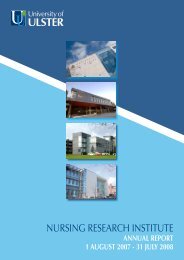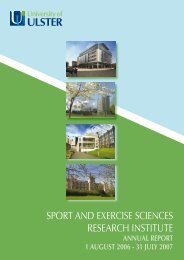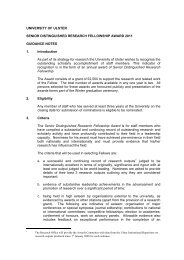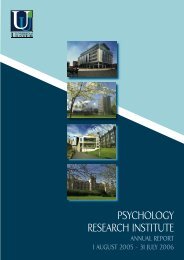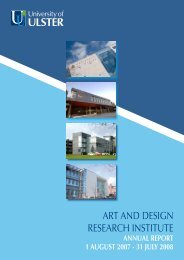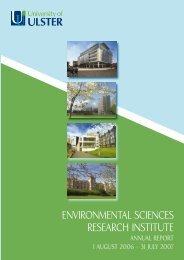biomedical sciences research institute - Research - University of Ulster
biomedical sciences research institute - Research - University of Ulster
biomedical sciences research institute - Research - University of Ulster
- No tags were found...
Create successful ePaper yourself
Turn your PDF publications into a flip-book with our unique Google optimized e-Paper software.
12. VISION SCIENCES RESEARCH GROUPRESEARCH STRATEGYThe Vision Science <strong>Research</strong> Group (VSRG) conducts investigations on the entire visual system, from the opticalelements <strong>of</strong> the eye: the cornea and lens to the retina and higher visual pathways. The underlying strategy is to studythe structural and functional aspects <strong>of</strong> the ocular elements and visual system and how these are applied to the study<strong>of</strong> developmental, growth and ageing processes. The main <strong>research</strong> themes in the group can be divided into clinicaland basic (laboratory) science:Laboratory Sciences:Optics: the optics <strong>of</strong> the lens and cornea are studied using ray tracing analysis, aberrometry, optical coherencetomography to determine changes with ageing, as the eye focuses and after refractive surgery.Biomechanics//Finite Element Analysis: the elasticity <strong>of</strong> the cornea and sclera is being measured by modelling the eyeballas a pressure vessel. Finite element analysis is used to model the optical/mechanical processes to determine howmechanical properties can impact on optical quality.Biochemistry/Cell biology: the protein chemistry <strong>of</strong> the eye lens is being studied to determine how the proteindistributions are linked to refractive index <strong>of</strong> the lens and cell culture techniques are used to look at damage toDNA in the cells from optical elements <strong>of</strong> the eye.Immunology: Immunological work had involved investigations <strong>of</strong> the ocular surface using patient samples, ocular surfacecells and donor tissue to identify biomarkers for application in translational patient based <strong>research</strong> which involvesdiagnostic and therapeutic approaches. Present <strong>research</strong> concentrates on two ocular surface conditions: HerpesSimplex Virus infection <strong>of</strong> the ocular surface and dry eye.Psychophysics: Psychophysical studies are being used to study the higher visual pathways as well as applied toinvestigations <strong>of</strong> age-related disease conditions such as glaucoma.Imaging: This work is conducted in collaboration with colleagues from Computing and Engineering and encompassesprojects on iris imaging to determine immutable features for biometric identification as well as retinal imaging forimproved diagnosis <strong>of</strong> eye disease.Clinical Sciences:Paediatric vision/epidemiological studies: Refractive errors in Northern Irish schoolchildren are being investigated in amajor epidemiological study that is the first <strong>of</strong> its kind.Developmental anomalies: Studies are being conducted on the ocular and optical anomalies in Downs syndrome andin Albinism.Geriatric/low vision: The association between ageing and eye disease is well known and these studies include work onmacular degeneration, glaucoma and the ocular effects <strong>of</strong> Alzheimer’s disease.Sports Vision: investigations are concerned with the effect <strong>of</strong> binocular vision on sports performance and how this canbe improved in a variety <strong>of</strong> different sports.Dyslexia: the effects <strong>of</strong> contrast and colour on reading, writing and learning ability are being investigated to comparevalidity <strong>of</strong> analytical methods and to determine the best methods <strong>of</strong> analysis, diagnosis and treatment for the childrenand adults who present with reading and writing difficulties.107



